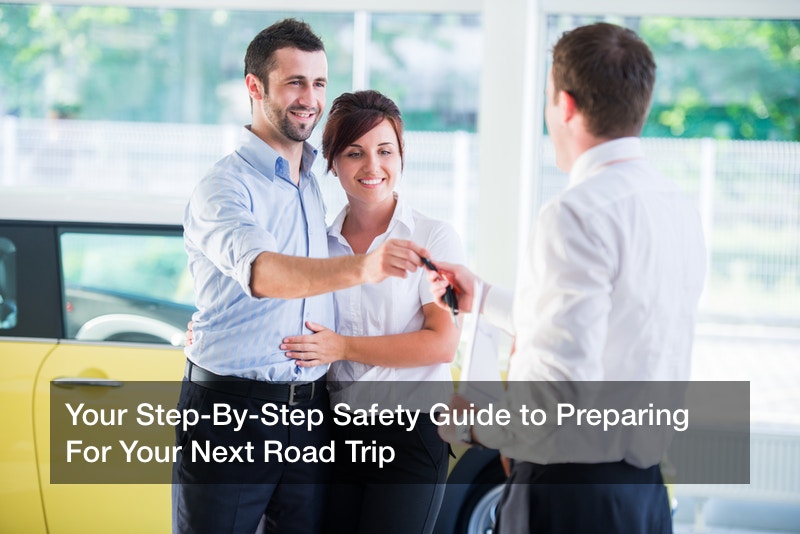
For many Americans, there’s nothing better than getting out on the open road. In fact, the ability to drive is often equated with the concept of freedom — and there’s nothing more American than that. With 222 million people with valid driver’s licenses in the U.S. during 2016, driving is clearly something the general population enjoys.
But, of course, operating a motor vehicle comes with its share of dangers, too. With nearly 1.25 million people dying in road collisions every year, it’s essential to take proper precautions before getting behind the wheel.
That’s especially true when you’re taking a road trip across the country. Now that summer is here, many families throughout the U.S. are probably considering planning a vacation like this. But before you head out, you’ll want to add some tasks to your road trip car maintenance checklist and make sure you take every step to stay safe during your journey. Let’s take a closer look at the American road trip, as well as some top tips to safely enjoy your getaway this summer.

Road Trips: An Ever-Popular American Pasttime
Astonishingly, U.S. road trips have been around since before cars could even be found on our streets. However, road trips didn’t really start to take off until the automobile became more accessible to the masses (and paved highways started to become commonplace). By the 1920s, road trips were a bit more popular. But it wasn’t until the 1960s and 1970s that American families really took advantage of their unique opportunity to see the wonders of the nation while driving on four wheels.
American road trips are still incredibly popular today. According to a recent survey, two out of three travelers reported their intentions to take a road trip during 2019. And while the ongoing COVID-19 pandemic has discouraged many from traveling too far from home, there are still plenty of people who want to see all of the local attractions the country has to offer — albeit with masks on their faces.

How to Prepare For Your Upcoming Road Trip
There’s no denying that road trips have mass appeal. And since air travel is one of the riskier activities you can partake in right now, many people feel that traveling by car is one of the best options available. Still, you’ll need to take a number of precautions to ensure your trip goes smoothly and that you stay safe. Let’s take a look at a few things to include on your road trip car maintenance checklist, as well as some other tasks to address before you head out.

Have Your Car Inspected
Owning a vehicle — whether it’s a used car or a brand new model — comes with a lot of responsibility. And although obtaining car insurance can protect your investment if you’re involved in a crash, you’ll want to do everything you can to prevent any kind of accident or negative incident on the road before it occurs.
Therefore, it’s important that you do your part to check out some basic components of your car or bring your vehicle to an experienced auto mechanic to ensure it’s up-to-date on all maintenance and that any necessary repairs are performed before you leave. Here are several things you’ll want to add to your road trip car maintenance checklist.
- Tires: You should inspect all four tires, as well as your spare, to ensure your tire tread isn’t too worn down or that your tires are poised for a flat. Be sure to check your tire pressure, too. This should be at the top of your road trip car maintenance checklist. After all, you can’t get too far without good tires.
- Brakes: The last thing you’d want is for your brakes to give out when you’re on a busy highway. Pay attention when braking for any vibrations or strange sounds (like grinding or squealing). If you sense something is amiss, take your car in for an inspection. Your mechanic will check to see if the pads and rotors are in good shape or if you have any fluid leaks to worry about. Brake repair should be prioritized to prevent accidents and injuries on the road.
- Fluids: Your car needs lubrication to operate as it should. Your engine oil, transmission fluid, coolant, and other lubricants should meet their recommended levels to ensure safe driving. Keep in mind that this may be part of your transmission tune-up so that this essential car part can also be inspected. In addition to topping off these fluids, you may want to look up oil change locations in your area if you’re due for this service.
- Battery: Car batteries are more likely to die in the winter, but there’s nothing that says this can’t happen during the summer. Be sure to check your current battery’s capacity (which many roadside assistance programs offer for free) before heading out. You should also make sure you have a set of jumper cables in your vehicle for emergencies. If your battery is on its last legs, it’s often worth the cost to replace it before your car refuses to start.
- AC and Air Filters: If you’re traveling somewhere known for its hot temperatures, you’ll definitely want to make sure your air conditioning is working as it should. Test out your AC before you leave to ensure the cabin will be cool during the entire trip. It’s also a good idea to change out your air filters, both in the engine and the cabin. These auto upgrades are very affordable and can often be installed without expert assistance, which makes them perfect candidates for your road trip car maintenance checklist.
- Lights: You won’t want to risk a night on a deserted road without fully functioning headlights. You also won’t want to give law enforcement a reason to pull you over in an unfamiliar area due to a burned-out taillight. Be sure to check all of your interior and exterior bulbs prior to your departure. You’ll be glad you added these tasks to your road trip car maintenance checklist.
Pack a Survival Kit
Creating and checking off items on your road trip car maintenance checklist is immensely important. But these aren’t the only steps you’ll need to take before taking a road trip. Once you’ve worked your way down your road trip car maintenance checklist and ensured your vehicle is ready to be driven, you’ll want to equip your vehicle with all of the supplies you’ll need.
You should create a kit with emergency supplies, including a flashlight (with extra batteries), first-aid products, basic tools, bottled water, non-perishable food, flares, reflectors, rain gear, paper towels, duct tape, gloves, disinfecting wipes, phone chargers, blankets, and a number of other items intended for the worst-case scenario. While you’ll hope to never have to use these items, they should always be on-hand just in case. Don’t forget the face masks and hand sanitizer!

Carefully Plan Your Route
Once you’ve taken care of everything on your road trip car maintenance checklist and put together your survival kit, it’s time to plan out the route you’ll take. While many of us rely solely on navigation apps and GPS devices, it’s a good idea to have back-up directions or a physical map in case the device dies, your signal drops, or the directions lead you astray. It may seem old-fashioned and like you’re preparing for a highly unlikely scenario, but it’s best to have your bases covered.
You’ll also want to plan out your stops along the way. You should never assume that you’ll be able to grab a hamburger or fuel up your gas tank in a given place, nor should you believe there’ll be a vacancy if you need to stay overnight at the last minute. It’s important to plan out ahead of time which rest stops you’ll use, where you’ll eat your meals, and where you’ll pump gas. This will give you time to research the areas in question to ensure they’re recommended for tourists. It’ll also allow you to figure out driving shifts if you’re sharing these responsibilities. That’s important to decrease the risk of drowsy or distracted driving. And since we’re in the midst of a pandemic, it’s best if you limit the stops you make and ensure that anywhere you stop is following all recommended safety precautions. If you fail to plan this out ahead of time, you could find yourself in a situation that makes you uncomfortable or even puts the health of your family at risk.
Get Everything Organized
After you run down your road trip car maintenance checklist, put together your emergency supplies, and plan out your route, you’ll want to ensure all of your important documentation is up-to-date and that your car’s interior is as organized as possible.
For one thing, you should ensure your vehicle registration, license, and insurance are all current and that you have all pertinent documentation in your car’s glove compartment or in your wallet. It’s also a good idea to consider travel insurance or a roadside assistance membership before you go. Then, you can start organizing the rest of the vehicle. Make sure charging cables, power adapters, music, and other electronics are kept in one spot to prevent loss or damage. Clean out cupholders, check under the seats, and make sure your trunk or hatch-back is free from any debris or items you wouldn’t want to bring with you. Add a bag of spare change for tolls (or ensure that your travel toll pass is current) and add a bag or small bin for trash that you’ll empty regularly during the trip.
While you’re at it, you might consider vacuuming out your car or having it professionally detailed before you leave. This can remove any dirt, dust, or debris you might otherwise miss. You could also have the car’s exterior washed, as this can improve your visibility and help you check the functionality of your wiper blades. And since viral transmission can be a concern for many families right now, it makes sense to start your trip off with a clean slate. It’s also just a nice ritual to adopt for any road trip. After all, you’ll want your car to look its very best! Once you return from your trip, it’s a good idea to clean your car again and bring it in for any necessary maintenance or repairs.
Taking a road trip can be an incredible way to create new and lasting memories with your loved ones. You’ll be able to see the country from the comfort of your own vehicle. And while many establishments may be closed or operating at limited capacity right now, it can still be a good way to spend time together. That said, you’ll want to follow all restrictions pertaining to cross-state travel and ensure that you’re prepared to quarantine upon your return. You can avoid this scenario by staying within your own state. Don’t forget that this can still count as a road trip! But no matter where you travel, you should always take precautions.
Now that you’ve worked your way through your road trip car maintenance checklist, included all necessary supplies, checked on your documentation, and cleaned the car inside out, it’s time to take one final test drive and fill up the gas tank. You can feel confident that once you put the key in the engine, you’ve done everything you can to prepare and prioritize the safety of those you love.
Keep in mind that your commitment to safety isn’t over once you pile in the automobile. You’ll have to observe all posted signs and follow all laws for driving behavior, too. For example, you’ll want to keep your phone put away, keep distractions to a minimum, and exercise extreme caution in inclement weather. But since you’ve prepared so well for your journey, you can load up the car with your luggage, put your seatbelt on, turn on the radio, and enjoy the feel of the wind in your hair as you head out on the highway — while abiding by proper safety limits, of course.




